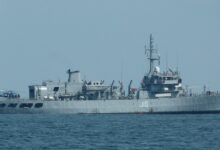Indian Navy Proactively Deploys Fleet To Deter Pirates, Affirms Chief Admiral Hari Kumar

- He said that Drishti could be a powerful force multiplier with its cutting-edge sensors, longer endurance, better communication tools, and new technologies.
- 'Drishti', he said, would be a key part of future naval operations that protect India's maritime interests in the Indian Ocean area.
The Indian Navy is sending out its fleet to keep the pirates away and keep them in their own seas, Admiral Hari Kumar, the Chief of Naval Staff, said on Wednesday. After showing off the Drishti 10 Starliner Unmanned Aerial Vehicle (UAV) made in India by Adani Defence and Aerospace for the Navy, Hari Kumar said that in the last 40 to 42 days, there have been about 35 drone attacks on ships, mostly on Israeli-owned, -flagged, or -related ships in the Red Sea, North Arabian Sea, and Central Arabian Sea.
Even though he didn’t name names, he said that India’s close neighbors have a lot of unmanned aerial vehicles (UAVs), so it makes sense for the country and its military to continue to use local experts in the field.
“There have only been two incidents recently (pirates trying to take over ships).” Both ships did not fly the Indian flag, but the crew on the second one was Indian, so we had to answer. So we got on board and saved the crew…”That’s why we’re sending our units there right now to make sure the pirates stay away,” he told reporters.
On Friday, the Indian Navy stopped an attempted capture of the Liberian-flagged ship MV Lila Norfolk in the North Arabian Sea and saved all of its crew, including 15 Indians.
The Chief of Naval Staff also said that operations against pirates have been going on since 2008 and that more than 105 ships have been sent out during that time.
When asked about drone attacks on ships, Hari Kumar said that the trash from the three ships that were attacked is being looked at by forensic scientists.
In his first speech to the group, he said that the country and its military should continue to use “our resident expertise” in the area of unmanned aerial vehicles (UAVs) because “both our immediate neighbors” have a lot of them.
He also said it wasn’t necessary to stress how important autonomous systems are in today’s fast-paced, technologically-driven fights.
They are having an unfair effect on the wars going on in Europe and West Asia, he said.
He also said that the “recent incidents” (which he seems to be referring to the hijacking attempts) in the North and Central Arabian Seas show how dangerous these systems can be when they are used by terrorists and non-state players.
He said that today, for many countries around the world, automated systems are becoming the best way to fight.
UAVs have been used by the Indian Navy for 20 years, but the arrival of “Drishti” represents the Navy’s goal to become a “atmanirbhar” force, he said.
He said that Drishti could be a powerful force multiplier with its cutting-edge sensors, longer endurance, better communication tools, and new technologies. It would be able to help with intelligence, surveillance, and reconnaissance activities all over the Indian Ocean region.
‘Drishti’, he said, would be a key part of future naval operations that protect India’s maritime interests in the Indian Ocean area.
At the event, Ajay Bhatt, Union Minister of State for Defence, said that the Drishti 10 (Starliner) would help keep a close eye on the seas.
He praised “Marcos” for saving crew members when pirates tried to take over a ship in the Arabian Sea recently. He said this shows that the country is becoming more independent and that people are becoming more confident in themselves.







Facebook Comments